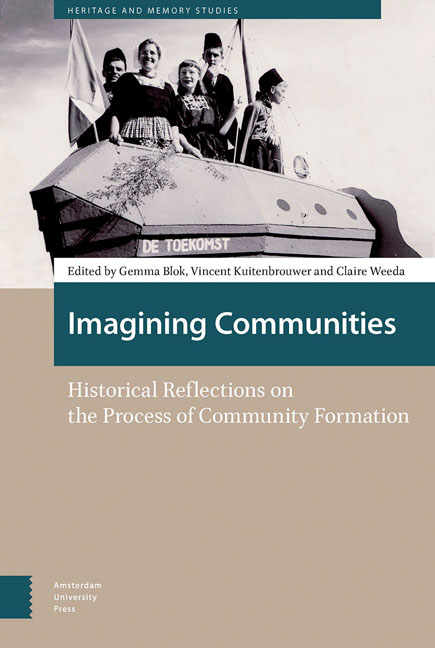Book contents
- Frontmatter
- Contents
- List of Figures
- Introduction
- 1 Meanwhile in Messianic Time: Imagining the Medieval Nation in Time and Space and English Drinking Rituals
- 2 Diverse Origins and Shared Circumstances: European Settler Identity Formation in the Seventeenth-Century Plantation Colony of Suriname
- 3 Imagining Europe: The Peace of Ryswick (1697) and the Rise of European Consciousness
- 4 Gypsy Music and the Fashioning of the National Community
- 5 ‘Tired, Worried and Overworked’: An International Imagined Community of Nervous Sufferers in Medical Advertisements, 1900-1920
- 6 ‘From Heart to Heart’: Colonial Radio and the Dutch Imagined Community in the 1920s
- 7 Indonesian Nationalism in the Netherlands, 1920s-1930s: Long-Distance Internationalism of Elite Pilgrims in Homogeneous, Empty Time
- 8 Time, Rhythm and Ritual: Imagined Communities in L’espoir (1937) and Les sept couleurs (1939)
- 9 Stamverwantschap and the Imagination of a White, Transnational Community: The 1952 Celebrations of the Jan van Riebeeck Tercentenary in the Netherlands and South Africa
- 10 ‘L’Oranie Cycliste, une grande famille’: Recycling Identities and the Pieds-Noirs Communitas, 1976-2016
- 11 Remembering and Imagining the National Past: Public Service Television Drama and the Construction of a Flemish Nation, 1953-1989
- Index
4 - Gypsy Music and the Fashioning of the National Community
Published online by Cambridge University Press: 11 December 2020
- Frontmatter
- Contents
- List of Figures
- Introduction
- 1 Meanwhile in Messianic Time: Imagining the Medieval Nation in Time and Space and English Drinking Rituals
- 2 Diverse Origins and Shared Circumstances: European Settler Identity Formation in the Seventeenth-Century Plantation Colony of Suriname
- 3 Imagining Europe: The Peace of Ryswick (1697) and the Rise of European Consciousness
- 4 Gypsy Music and the Fashioning of the National Community
- 5 ‘Tired, Worried and Overworked’: An International Imagined Community of Nervous Sufferers in Medical Advertisements, 1900-1920
- 6 ‘From Heart to Heart’: Colonial Radio and the Dutch Imagined Community in the 1920s
- 7 Indonesian Nationalism in the Netherlands, 1920s-1930s: Long-Distance Internationalism of Elite Pilgrims in Homogeneous, Empty Time
- 8 Time, Rhythm and Ritual: Imagined Communities in L’espoir (1937) and Les sept couleurs (1939)
- 9 Stamverwantschap and the Imagination of a White, Transnational Community: The 1952 Celebrations of the Jan van Riebeeck Tercentenary in the Netherlands and South Africa
- 10 ‘L’Oranie Cycliste, une grande famille’: Recycling Identities and the Pieds-Noirs Communitas, 1976-2016
- 11 Remembering and Imagining the National Past: Public Service Television Drama and the Construction of a Flemish Nation, 1953-1989
- Index
Summary
Abstract
Gypsy music has long been emblematic of Hungarian national identity. The presence of Roma musicians in Hungary dates from the fifteenth century, and Gypsy music has been regarded as part of the Hungarian national heritage since the early eighteenth century, when the Roma played a significant role in the Rákóczi uprising. Roma musicians were later employed by the Habsburg army to provide entertainment during recruiting events. Verbunkos, or recruitment music, has become associated with the Hungarian national style. This chapter explores the role of material culture in establishing the link between Gypsy music and Hungarian national identity. It examines the interactions and correlations among music, materiality, and history writing, and explores the ways in which the Roma community has been imagined and framed as part of the nation, and conversely, how Hungarian patriotic feelings have been shaped by Roma musicians.
Keywords: nationalism, music, Gypsy, Roma, verbunkos, materiality, imagined community
How did the Gypsy musical tradition grow into an emblem of the Hungarian national style? In the age of nineteenth-century European nation-building, when national communities were imagined along the lines of ethnic myths and a common historical consciousness, how could a community that was living on the fringes of society become central to the national image? This article seeks to explore the interplay between collective identity, musical culture and the plasticity of national stereotypes. What circumstances and social positions shaped the romanticized image of the Roma people in Hungary? How were the feelings of belonging of the Roma people navigated in public discourse in the period of European nation-building? How did they define themselves, and how did they figure in the imagined community called the nation? How were practices of community building and belonging experienced through material culture with symbolic national value (such as garments or musical instruments)?
My aim is twofold: on the one hand, to throw light on the ways in which Gypsy music shaped national identity, and on the other, to examine the ways in which the Gypsy musical tradition has been framed in both positive and negative terms according to ideas of the national self-image. National styles have been shaped by the interaction between local and transnational exchanges, and the relationship between the imagined and imagining communities did not result in a fixed identity. Instead, it changed over time and was defined by a dynamic process of both inclusion and exclusion.
- Type
- Chapter
- Information
- Imagining CommunitiesHistorical Reflections on the Process of Community Formation, pp. 77 - 96Publisher: Amsterdam University PressPrint publication year: 2018

